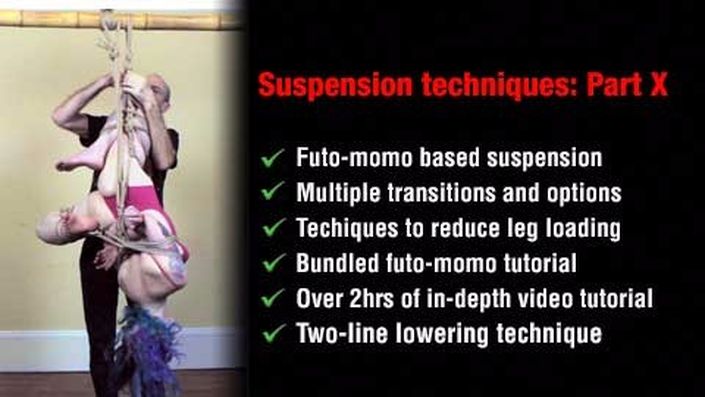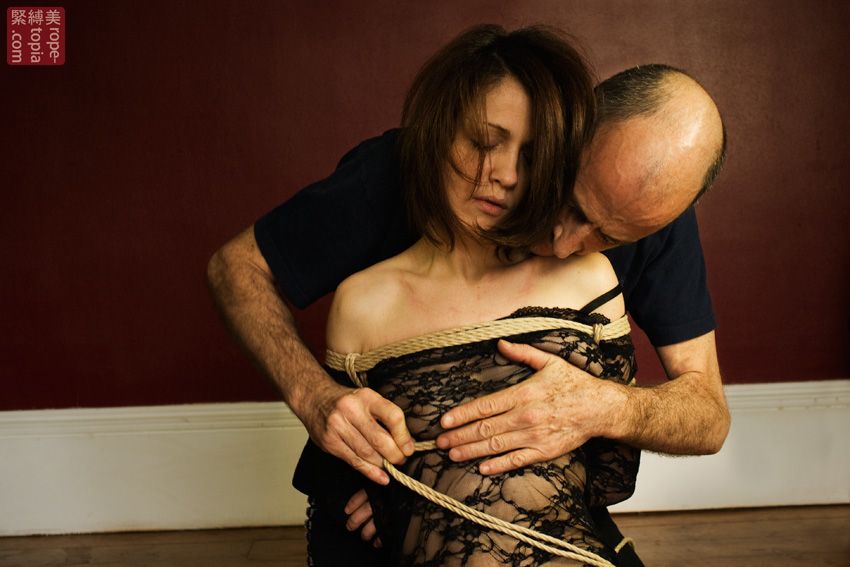
m) Suspension techniques: Part X
A futo-momo based shibari suspension with transitions
In this tutorial, building on the skills of the preceding parts, I take you through the steps to safely perform a futo-momo (shin to thigh tie) based inverted suspension sequence. This is only one of many ways of ending up with this position. However, this method has been chosen because it mitigates risk by the use of a secondary main line and minimises the need for strength since it largely uses gravity. Of course, one can achieve the position from a dead-lift via the futo-momo but it requires more skill and strength to perform safely. You'll also learn a technique that makes the futo-momo easier to apply with control and elegance

As the futo-momo is a key ingredient and relies on being tied properly, our very comprehensive tutorial on this tie has been included to make sure you fully understand this versatile tie and get it 100% right.
Topics covered include:
- Fast wrapping versions
- Single column bases
- Double column bases
- Building stems
- Suspension capable versions
- The 'no-pinch cinch'
- Effective wrap positioning
- Efficient handling techniques
- Body control

Inversions carry a high risk of serious injury if you lose control or drop your partner since their head is likely to be the first thing to hit the ground. With this in mind, you will learn how to split the load with the gote for greater safety, potential comfort and, most importantly, to give you the confidence that your partner won't meet the floor head first.
As I demonstrate suspending from the top wrap/stem of an old-style gote, the tutorial on the X-friction modification has been included, as it is essential if you prefer the more common contemporary takate-kote (2TK/3TK) and wish to suspend this way.
There's a special section on choosing, positioning and building the right suspension linkage. This is important as a small change can make the difference between heaven and hell.
As with all our tutorials, this is not a set recipe, more a way of doing things. To illustrate this, we include a performance based on the techniques you will learn in this tutorial. Whilst, you should first become familiar with the routine as is, I illustrate many potential variations for you to open up your creative options to allow you to adapt to the situation, your partner and make it your own..
Your Instructor

Esinem is a shibari artist who has regularly appeared at UK and international events such as Pride, Torture Garden, Erotica, Rubber Ball, Wasteland, Boundcon, Nuit Demonia and recently represented the UK at Japan's first international kinbaku event, Toubaku. He is also known for his teaching both in the UK and internationally and was co-organiser of the London Festival of the Art of Japanese Bondage and BOUND, Europe's premier monthly shibari event.
Over the last few years, he has been improving his skills in Japan with the help some of their best known and respected kinbakushi, Arisue Go, Osada Steve, Kinoko Hajime, Kazami Ranki and, grand master of newaza, Yukimura Haruki. Whilst drawing from classical methods, his style is distinctive and epitomizes the art of communicating with rope, often departing from the typical serenity of shibari shows and flying in the face of tradition to produce some striking and unusual performances.
In addition, he has worked on various videos, e.g. Primal Scream's 2013, artistic collaborations and photo shoots both on and off camera. He has been involved in projects providing inspiration for Tom Ford's 2013 collection and, Raqib Shaw, an acclaimed artist who has exhibited at the Tate, Metropolitan and White Cube galleries.
He contributed to Rope, Bondage & Power, edited by Lee Harrington and is currently involved with a number of documentaries on kinbaku. He is also author of the first English language tutorial DVDs: 'Japanese Rope Bondage: Tying people, not parcels'.
Nina Russ is a London based, shibari performer, rope artist and educator. She became student of Esinem in 2011 and their collaboration gave birth to BOUND shibari night (2012) and ShibariClasses (2015). She had also the fortune to participate at workshops with different Japanese shibari masters, like: Kazami Ranki, Yukimura Haruki, Kinoko Hajime.
She has performed internationally, most notably at the London Festival of the Art of Japanese Rope Bondage and RopeFest in St.Petersburg. In addition, she participates in numerous artistic, fashion collaborations and local performances. Her passion for rope has lead her on a route of discovery of concepts, philosophy, aesthetics and benefits behind this Japanese discipline.
She sees shibari as an art form which creates deep connection between the participants and also aids personal development. Due to its martial arts roots, it brings self-discipline, efficiency, effectiveness and, thus, growth in confidence and awareness. She believes these skills allow a greater focus on the most important aspects: you, your partner and your shared experience.
